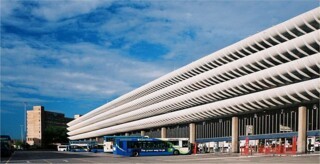Save Preston Bus Station
Gillian Darley
One night in early 1961 Tom Driberg stood up in the House of Commons to appeal against the imminent demolition of the listed London Coal Exchange. An early Victorian Pantheon in iron and glass, it stood in the path of the proposed Lower Thames Street:
If there were a proposal to pull down St Paul's or St Stephen’s, Walbrook, for road development, obviously the Minister would never allow it – but just because, and only because, the Coal Exchange was built in the 19th century, instead of the 18th or the 17th century, the threat is real... Victorian architecture at its best can be very fine indeed. There are always these cycles of taste. Not only the architects, but the poets, painters, novelists of the period immediately preceding our own are out of fashion; then we begin to be interested in them again, and can see them in perspective.
Driberg evoked Sir Mortimer Wheeler’s defence of the Coal Exchange (‘imagine the rolling eye, the superb moustachios, and the orotund enunciation’). Television’s first celebrity archaeologist was drawn into the campaign because there was a Roman hypocaust below the Coal Exchange. Wheeler, Driberg said, believed it ‘a national monument in the fullest sense of the phrase, and its destruction would be unforgivable. Those are very strong words, as the minister will agree.’ Driberg also quoted Betjeman, Pevsner (who thought the Coal Exchange one of the 12 finest Victorian buildings) and Ian Nairn, who said: ‘This building was how [Robert] Adam might have built if he had lived in the mid-19th century.’
If Victorian architecture was still unappreciated in the 1960s, so 1970s Brutalist architecture remains a minority taste in the 21st century. Nairn’s 1975 film on Bolton and Preston (part of his fine series on football towns) was presented from a deck of Preston Bus Station, currently slated for demolition. ‘This is a multi-storey car park with a difference,’ he proclaimed, as the camera pulled back to show him, pea-sized, looking down. ‘If you think that concrete exposed always has to be mean and messy then look at the grand sweep of this, the strength and also the elegance.’ He judged it a ‘truly great building’. In the Huddersfield and Halifax film in the same series, Nairn was as impressed by the bold, immense Halifax Building Society, designed, like Preston Bus Station, by Building Design Partnership. ‘For any one firm to have done two buildings of that scale and quality in ten years I would call a life-time’s achievement,’ Nairn said. The Halifax building has just been listed.
But there has been no impassioned debate about Preston Bus Station in the House of Commons: quite the reverse. In November 2009, the Labour MP for Preston, Mark Hendrick, hoped the minister (Margaret Hodge) would ‘resist any temptation to list Preston bus station, which has little or no architectural merit and has had an application rejected in the past. The current application is being used purely as a tactic to stop the redevelopment of Preston city centre.’ Hodge answered that she was unaware of ‘that particular building’ but wasted no time in overruling English Heritage’s second recommendation for listing. The proposed retail development on the site withered on the branch. Now might be time for the honourable member for Preston to offer his support to the three local men who, in recent days, have stepped forward with a potentially viable plan, keeping the building.

Comments
I support the preservation of Preston Bus Station mainly because the alternative is apparently a shopping mall and we can guess what that's going to look like. The Council says it's going to cost £17m to save it, and they don't have that kind of money, but I got the feeling that they didn't have any energy to try, either. Although in my opinion its length gives it so-called 'architectural merit' (it gets a page in Martin Parr's wonderful Boring Postcards), I doubt that the bus station is a significant piece of Brutalism. The only grounds seem to be that it's got a precast concrete facade and was built in the early '60s. Apart from that, I don't think it's got much to do with le Corbusier or, say, Dennis Lasdun's National Theatre on the South Bank or the Park Hill Estate.
Finally, there are reasons why Preston Bus Station isn't comparable to a Victorian coal building. Because of Modernism, by the 1950s it seemed to most people crazy that the Victorians had wanted to elevate public works - underground stations, utilities, public lavatories and other sewage-related structures - to the same level as other public buildings. By the 50s & 60s, most designers would have distinguished between 'servant' and 'served' buildings whereas the Victorians did the opposite, they deliberately blurred any distinction. Take this example. It isn't a church, or even a public building, it's Crossness Pumping Station, a typical part of the sewage system built for London in the late 1850s and abandoned to rust in the 1950s, about the time the Brutalists were getting started. The Victorians weren't perfect, but compared to the Brutalists or to Mr Gove & his meanness about building new schools and compared to the quality of public works today they had good points.